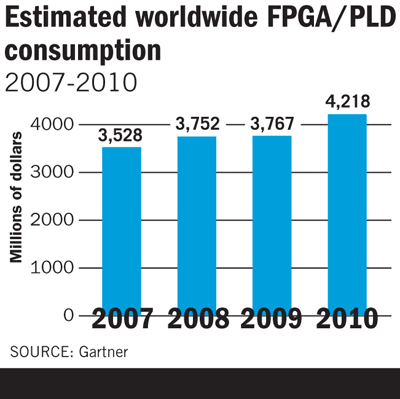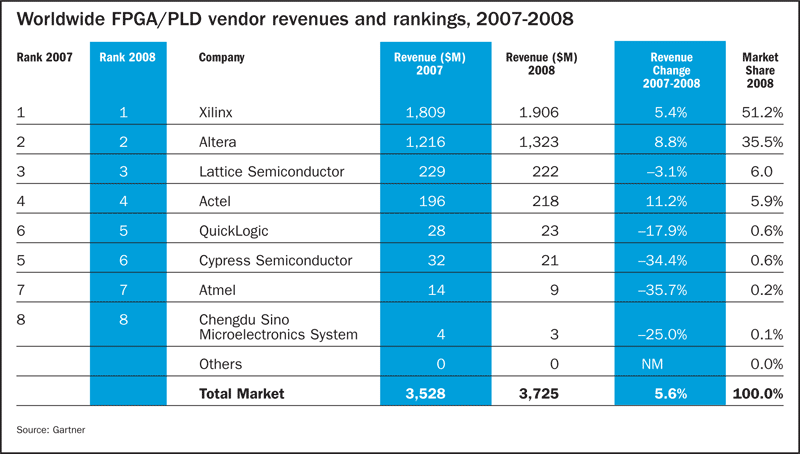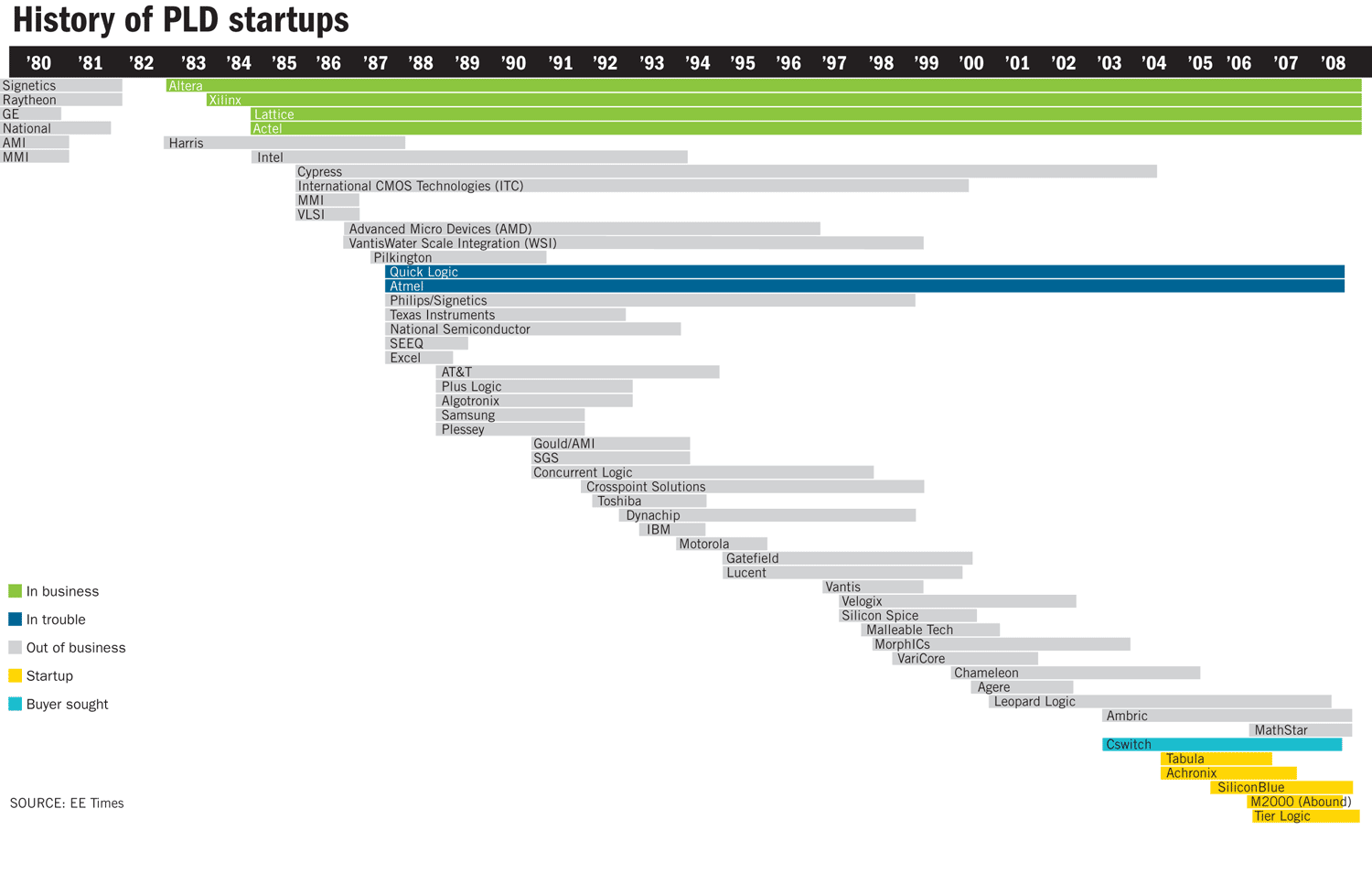![]()
작성일: 2017.03.31
Dylan McGrath - July 27, 2009
Cswitch Corp. made waves and headlines in 2006 when it unveiled a novel configurable array architecture said to be capable of narrowing the performance and density gaps between field-programmable gate arrays and application-specific ICs. But last month, less than three years later, investors pulled the plug, halting operations at Cswitch and moving to seek a buyer for the programmable logic startup's assets and intellectual property.
Even with the demise of Cswitch, today there are at least five active programmable logic startups whose outlooks are considered promising--more than at any time in recent memory. The companies appear to be well funded, with compelling technology and focused management teams.
But to succeed, they will have to overcome not only entrenched competitors and a brutal downturn, but a history that has not smiled on their kind.
Cswitch is the latest casualty in a programmable logic market that has hosted more than 50 entrants since 1983. The vast majority have failed, whether succumbing to acquisition, retreating into other markets or simply closing up shop. The list of the vanquished includes once well-regarded startups like Gatefield Corp. (acquired by Actel Corp. in 1999) and Velogix Inc., as well as semiconductor industry stalwarts such as Intel Corp., Samsung Electronics Co. Ltd. and Texas Instruments.
Just last year, two programmable logic vendors closed their doors: Ambric Inc. shut down after it ran out of funding, and publicly traded MathStar Inc. ceased operations after failing to find a buyer.
Programmable logic veterans cite several reasons for the history of failures, including targeting too narrow a market niche and failing to "get the tools right." Because programmable logic vendors have traditionally provided software design tools to users at very low or no cost, the price of entry in this market includes not just silicon R&D, but software R&D as well.
Another reason the startups have struggled is simply that the entrenched leaders have proved difficult to unseat. Market watcher Gartner Inc. estimates that Xilinx Inc. and Altera Corp. together accounted for nearly 87 percent of the programmable logic market in 2008 (holding 51.2 percent and 35.5 percent, respectively). Two smaller but well-established players, Actel Corp. and Lattice Semiconductor Corp., each held about 6 percent.
Insiders say startups need to demonstrate clear and compelling technology advantages if they hope to take business from the established competitors, which have significant resources and offer stability and familiarity. A slight technology edge is not going to compel OEMs to take a chance on someone new.
"Any startup that enters the market with the intent to compete directly with strong incumbents in their core markets should stop and take a look at the trail of failed attempts," said John Lofton Holt, founder, chairman and CEO of startup Achronix Semiconductor Corp. "This is true in any industry but particularly true in a highly capital-intensive business like semiconductors, where the financial barrier to entry is very high." Holt maintains that Achronix does not compete directly with Xilinx or Altera.
By contrast, Frederic Reblewski, co-founder and CEO of startup Abound Logic Inc., makes no bones about his company's head-to-head competition with Xilinx and Altera in the market for high-end FPGAs. But Reblewski acknowledged that it would be impossible to compete without highly differentiated technology. "Nobody in his right mind would want to be in a price war with those two companies, with all of the money they have," he said.
The startups' prospects for success are further complicated by the industry downturn, as OEMs, wary of getting involved with any company that might not have the financial wherewithal to stick around, vet suppliers with particular care.
Sketchy detailsThat process can be tough on the FPGA startups, which are long on claims but short on specifics. As private companies, they don't publish financial results. Some claim a number of design wins but say they are prevented by contractual obligations from divulging customer names.
And while analysts say they like what they hear from the group as a whole, they agree that it's very difficult to assess the companies' prospects for success, given the lack of concrete information.
"The bottom line is: Show me the money," said Bryan Lewis, an analyst at Gartner Inc.
 |
Analysts like Lewis and Rich Wawrzyniak of Semico Research Corp. attribute the rise in programmable logic startup activity at least partially to the expiration of several key patents once held by the established players. Patents considered critical to the birth of FPGAs began expiring a few years ago. They include the original FPGA patent (U.S. Patent No. 4,870,302), issued to Xilinx co-founder Ross Freeman in 1988.
"Up until very recently, most patents were controlled by Xilinx and Altera. If you wanted to get into the market, you had to license the technology from them," Wawrzyniak said. "A lot of those seminal patents have expired or are about to expire."
But veterans of the programmable logic market disagree. The patent expirations, they say, have little, if anything, to do with the current crop of startups. Instead, they attribute the startup activity to a belief that the use of programmable logic is poised to grow at the expense of ASICs, for which design costs are on the rise. At a meeting in January, Xilinx president and CEO Moshe Gavrielov predicted that a combination of costs, market forces and technology drivers would result in FPGAs' displacing ASICs and application-specific standard products in all but very high-volume applications.
"Programmability is clearly the way forward in digital electronics," said Chris Balough, senior director of tools and software marketing at Altera. "If you are going to do something as a startup, almost by definition it's going to be a programmable product."
Software a critical requirementChristian Plante, director of marketing for low-power and mixed-signal FPGAs at Actel, said the FPGA market attracts startups partly because of the business model, where one chip fits many markets, with the potential for high gross margins. "Given that the FPGA market is no longer a crowded market, it looks appealing," Plante said. "But the barriers to entry are quite high, with a large investment needed not only in chip design, but also in software tools."
The big FPGA vendors treat design tools as loss leaders. Altera's customers, Balough said, have "grown to expect tools of tremendous sophistication priced at an artificially low level." Xilinx has more software engineers than hardware engineers; at Altera, the mix is roughly 50-50.
 Click on image to enlarge. |
Third-party EDA firms like Synopsys Inc. and Mentor Graphics Corp. offer front-end synthesis tools that are vendor-independent. But back-end place-and-route tools require tighter coupling with an FPGA vendor's architecture. The startups say they have robust tools that offer a familiar experience for seasoned FPGA users. In developing these tools, some of them, including Achronix and recent casualty Cswitch, engaged India's SoftJin Technologies Pte. Ltd., which creates customized design tools using a combination of EDA building blocks and services.
But according to Mark Moran, senior product manager of FPGAs at Xilinx, it's not enough simply to offer a set of tools that a designer can use to implement a design in an FPGA. Over the years, at the urging of customers, Xilinx has devoted countless man-hours to upgrading tool efficiency; the work has improved runtime, memory footprint and quality of results, Moran said.
"All of these types of things are not things you can build instantly," he said.
See also: Sizing up the contenders
출처: http://www.embedded.com/electronics-news/4083730/FPGA-startups-stare-down-giants-and-ghosts-item-1
![]()
![]() Send to a colleague |
Send to a colleague |
![]() Print this document
Print this document
